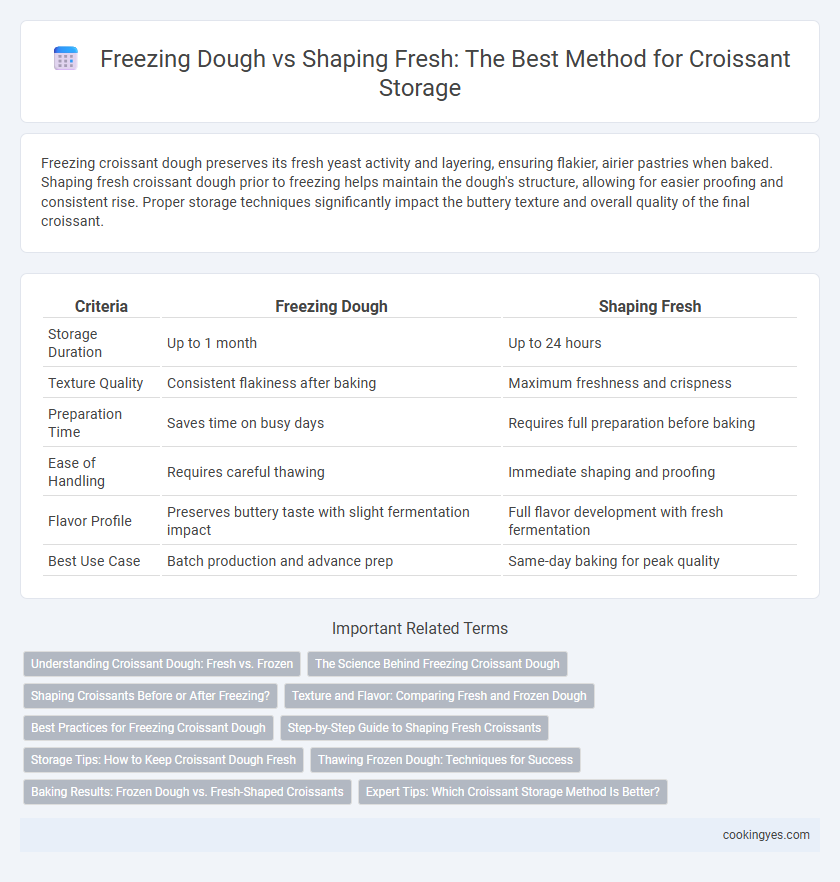Freezing croissant dough preserves its fresh yeast activity and layering, ensuring flakier, airier pastries when baked. Shaping fresh croissant dough prior to freezing helps maintain the dough's structure, allowing for easier proofing and consistent rise. Proper storage techniques significantly impact the buttery texture and overall quality of the final croissant.
Table of Comparison
| Criteria | Freezing Dough | Shaping Fresh |
|---|---|---|
| Storage Duration | Up to 1 month | Up to 24 hours |
| Texture Quality | Consistent flakiness after baking | Maximum freshness and crispness |
| Preparation Time | Saves time on busy days | Requires full preparation before baking |
| Ease of Handling | Requires careful thawing | Immediate shaping and proofing |
| Flavor Profile | Preserves buttery taste with slight fermentation impact | Full flavor development with fresh fermentation |
| Best Use Case | Batch production and advance prep | Same-day baking for peak quality |
Understanding Croissant Dough: Fresh vs. Frozen
Croissant dough's delicate lamination and yeast activity respond differently to freezing versus fresh shaping, affecting texture and rise. Freezing dough halts fermentation, preserving layers but requiring precise thawing to maintain flakiness and buttery crumb. Shaping fresh croissants allows immediate proofing and baking, yielding optimal puff and crispness but demands timely preparation and consumption.
The Science Behind Freezing Croissant Dough
Freezing croissant dough halts yeast fermentation and enzymatic activity by lowering temperatures below freezing, which preserves the dough's gluten structure and prevents over-proofing. Ice crystals formed during freezing can affect dough elasticity, but proper freezing techniques minimize cell damage, ensuring the dough rises optimally when thawed. This preservation of biochemical activity allows for consistent lamination and flaky texture after baking, making frozen dough a practical option for maintaining quality in croissant production.
Shaping Croissants Before or After Freezing?
Shaping croissants before freezing allows the dough to maintain its layered structure and ensures even rising during the final proof, resulting in a flakier texture and superior oven spring. Freezing the dough in pre-shaped croissants also simplifies thawing and proofing, reducing preparation time prior to baking. In contrast, freezing unshaped dough can lead to irregular layers and a denser crumb due to uneven thawing and handling.
Texture and Flavor: Comparing Fresh and Frozen Dough
Freezing croissant dough preserves the lamination, resulting in a flakier, buttery texture after baking compared to shaping fresh dough, which yields a slightly denser crumb due to immediate fermentation. Frozen dough allows the yeast to develop slowly during thawing, enhancing complex flavor profiles, whereas fresh dough offers a more straightforward, mildly yeasty taste. Optimal croissant texture and flavor depend on controlled freezing techniques that maintain dough moisture and layering integrity.
Best Practices for Freezing Croissant Dough
Freezing croissant dough at the intermediate proof stage is the best practice to preserve its delicate layers and flavor, enabling a controlled final proof after thawing. Wrapping the dough tightly in plastic wrap and placing it in an airtight container prevents freezer burn and maintains dough moisture. Thawing slowly in the refrigerator for 12 to 24 hours before shaping and baking ensures optimal texture and rise.
Step-by-Step Guide to Shaping Fresh Croissants
Shaping fresh croissants involves rolling out the laminated dough into a large rectangle, cutting it into evenly sized triangles, and carefully rolling each triangle from the base to the tip to form the classic crescent shape. Proper shaping ensures consistent layering and even baking, which contributes to the flaky, buttery texture characteristic of high-quality croissants. Allow the shaped dough to proof at room temperature before baking to achieve optimal rise and crispiness.
Storage Tips: How to Keep Croissant Dough Fresh
Croissant dough stays best when wrapped tightly in plastic wrap and refrigerated for up to 48 hours to maintain its optimal texture and flavor before baking. For longer storage, freezing the dough in an airtight container preserves its yeast activity and buttery layers for up to one month. When thawing frozen dough, place it overnight in the refrigerator and allow it to proof gradually at room temperature to ensure perfect rise and flakiness.
Thawing Frozen Dough: Techniques for Success
Proper thawing of frozen croissant dough is crucial to preserve its flaky texture and buttery layers. The dough should be thawed slowly in the refrigerator for 12 to 24 hours, allowing uniform temperature distribution that prevents yeast overactivation and butter melting. Gently bringing the dough to room temperature before shaping ensures elasticity while maintaining delicate lamination essential for a perfect rise and crisp crust.
Baking Results: Frozen Dough vs. Fresh-Shaped Croissants
Freezing croissant dough preserves its yeast activity and enhances flavor development during slow fermentation, often resulting in flakier layers and a richer taste compared to fresh-shaped croissants baked immediately. Fresh-shaped croissants typically achieve a lighter texture but may lack the depth of flavor gained from frozen dough's extended resting period. Baking results favor frozen dough for complex aroma and crispiness, while fresh-shaped croissants excel in quick preparation and tender crumb.
Expert Tips: Which Croissant Storage Method Is Better?
Freezing croissant dough preserves yeast activity and gluten development, allowing controlled fermentation and flaky layers when baked, while shaping fresh croissants ensures immediate freshness but requires precise timing for optimal rise and texture. Experts recommend freezing dough for extended storage to maintain buttery lamination and reduce waste, whereas fresh shaping suits same-day consumption to capture peak aroma and crispness. Temperature control, proper wrapping, and gradual thawing are crucial for both methods to achieve superior croissant quality.
Freezing Dough vs Shaping Fresh for Croissant Storage Infographic

 cookingyes.com
cookingyes.com